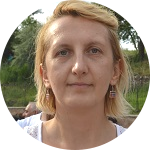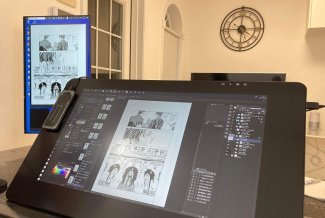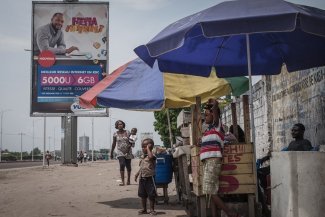In Bosnia and Herzegovina, the anti-smoking warning on cigarette boxes is written in country’s three official languages, even though the phrase “Smoking kills” is exactly the same in all of them. The only difference is that the Serbian version is written in Cyrillic script.
Vesna Smital is a proofreader for Bosnian, Croatian and Serbian languages at BHRT, the Bosnian national public broadcaster. Her job is to detect grammar, spelling and punctuation errors in drafts versions of television news scripts and correct them. That’s the easy part. The word choice and syntax are trickier because Smital has to make corrections based on three different sets of linguistic rules, depending on which of the three national languages each journalist says they speak.
“It was hard in the beginning,” she says. “I had to write down for myself who in the newsroom speaks which language and how particular words are said in each language.”
Now, after 13 years of practice, she finds it much easier to cope with the differences in terminology and syntax. “I always say to new colleagues: ‘You have to follow the politics and get to know it very well to do this job.’”
And politics is exactly what created a system in which Bosnia and Herzegovina (BiH) has three official languages, despite each language only having minor, sometimes manufactured, differences.
When war broke out in the former Yugoslavia in the 1990s, ‘Serbo-Croatian’, which was spoken throughout the country, was fragmented into multiple new languages: Serbian, Croatian, Bosnian and Montenegrin. Post-war governments started treating each language as separate in a bid to establish independent national identities, even if linguistically the languages are practically the same.
Driven by nationalist ideas, some linguists wrote new grammar books and created new orthography rules to separate their language from the others as much as possible, but they could only go as far as imposing new (and distinct) words or emphasising slight differences in the composition of sentences. Communication, however, was never jeopardised because the grammar and major part of the vocabulary stayed the same. The biggest difference is that the Serbian language tends to be written in Cyrillic, even though the Latin alphabet prevails in all languages due to globalisation. Both scripts have historically been interchangeable and many speakers of all four languages can read both Latin and Cyrillic letters.
In post-Yugoslav Croatia, Serbia and Montenegro, a newly-named tongue (Croatian in Croatia, Serbian in Serbia, Montenegrin in Montenegro) became inaugurated as the national language in each country. But Bosnia – where the majority of the population is made up of three different ethnicities (Croats, Serbs and Bosniaks), who all take part in the decision-making – installed Croatian, Serbian and Bosnian as its official languages. Citizens of BiH like to joke that over the night, they all became polyglots.
Bosnia’s ‘three-in-one’ recipe
The recognition of Croatian, Bosnian and Serbian as three distinct languages led to a costly triumvirate system of public administration, public broadcasting and education.
The Dayton Peace Agreement, which ended the 1992-1995 war, was written and signed in all three languages. It was then that the ‘three-in-one’ practice was rolled out. In post-war Bosnia, all official documents are ‘translated’ into three versions. The country’s ethnic divisions, encouraged by mainstream politics, take root – and pride – in parliament’s halls. If you visit the web site of the Federal Parliament, for example, you will have to choose which of the four languages you want to browse in – Bosnian, Croatian, Serbian or English. Civil servants, for example, ‘translate’ and proofread working materials and draft laws in all three languages. Some MPs complain if they don’t receive all documents written entirely in their own language, according to local media reports.
In an episode of the popular satirical pre-war TV show Top lista nadrealista (also known as Nadrealisti, meaning ‘Surrealists’ in English), a man who speaks ‘Herzegovinian’ wants to ask a Serbian-speaking woman out for a coffee. They cannot understand each other without the help of an ‘interpreter’ who simply ‘translates’ their conversation by repeating the exact same sentences they had just said. At the time the episode aired, this bizarre situation was a result of the creators’ witty imagination, but it depicted the absurdity of a reality soon to come.
At BHRT, where Smital works, the grammar and style take priority over orthography, while rules on the differences between the languages are not rigid. However, TV viewers can be. “It’s funny when people call us to complain because the word tisuća (a Slavic word meaning ‘thousand’ that is related to Croatian) was written in Cyrillic script,” Smital says.
But behind the ridiculousness of a system that causes laughter – even if it’s a bitter one – there’s another, disheartening consequence of these divisions.
In 34 so-called ‘two schools under one roof’ across Federation of BiH (one of Bosnia’s two entities, Republika Srpska being the second), students are separated into mono-ethnic classes and are taught different curricula in different languages. Such divisive policies limit interactions between generations of young people, who – even when attending the same schools – remain strangers to each other. Politicians justify the segregation by citing the right to education in one’s mother tongue, while human rights groups describe it as a form of segregation. One organisation, Vaša prava (Your Rights) BiH, has filed discrimination lawsuits insisting on the unification of Bosnia schools, but without success until now.
In the Serb-majority Republika Srpska (RS), the Bosnian language is described in schools as the ‘language of the Bosniak people.’ Politicians in RS consider the term ‘Bosnian language’ a perfidious attempt by ethnic Bosniaks to impose their language as the dominant one in Bosnia, while jeopardising the rights of its two other constituent peoples. Bosniak politicians, however, strongly oppose the arbitrary renaming of their language, and it has been the subject of heated political debates for many years. As with every election, the conflict over language has bled into the campaigning for the forthcoming parliamentary and presidential elections (set for 7 October 2018), with each nationalist party arguing their nation’s identities – and languages – are under the threat.
“The language belongs to all of us”
In spite of nationalist politics, many experts from the Balkans agree that Bosnian, Croatian, and Serbian and Montenegrin are one language with different names. In her book Language and Nationalism published in 2010, Croatian linguist Snježana Kordić argues that what was once called Serbo-Croatian is a polycentric language, currently divided by prevailing policies of nationalism. A similarly polycentric language is English, which has different characteristics in the United States, the United Kingdom and Australia, for example, but it is still the same language. “The demand for the creation of three versions of documents, separate television channels and school curricula due to allegedly different languages, cannot find justification in linguistics or the reality of the language,” Kordić said in an interview for N1 TV station two years ago.
Following the same reasoning, civil society campaigners and linguists from Bosnia and Herzegovina, Croatia, Serbia and Montenegro created the Declaration on the Common Language in March 2017, claiming that there’s only one language with different variants.
Sandra Zlotrg, who heads the Sarajevo-based Linguists Association is one of the signatories. “The Declaration was initiated by civil society and signed by language experts and people who do not have any direct links with linguistics, which is great. The language belongs to all of us and it matters to all of us,” she told Equal Times.
The fact that everyone speaks a common language does not prevent any individual from calling it what they want, nor does it impede their right to express their affiliation to any ethnic group or country, the Declaration states. Thousands of intellectuals, artists and public figures from the region have signed it since its launch last year, but it was strongly opposed by nationalists from all sides in the various former Yugoslav republics.
Some linguists have, in the meantime, softened their previously strict linguistic positions. Professor Senahid Halilović, the creator of the Bosnian language orthography norm, was motivated to make Bosnian a distinct language when he first designed the rules in the 1990s. He was a proponent of archaic use of the letter “h” (for example: ‘kahva’ instead of ‘kafa, meaning ‘coffee’ or ‘mahana’ instead of ‘mana’, meaning ‘defect’) but in many cases he was against double orthographic solutions. In spring this year, he joined the Declaration on the Common Language and published a new and updated edition of his book, which has been praised as much more inclusive and open to linguistic differences.
“This edition will most certainly be used also by those who did not appreciate the exclusivity of the first version,” says Smital. And that leaves many Bosnians hopeful that it might act as a bulwark against further divisions.










